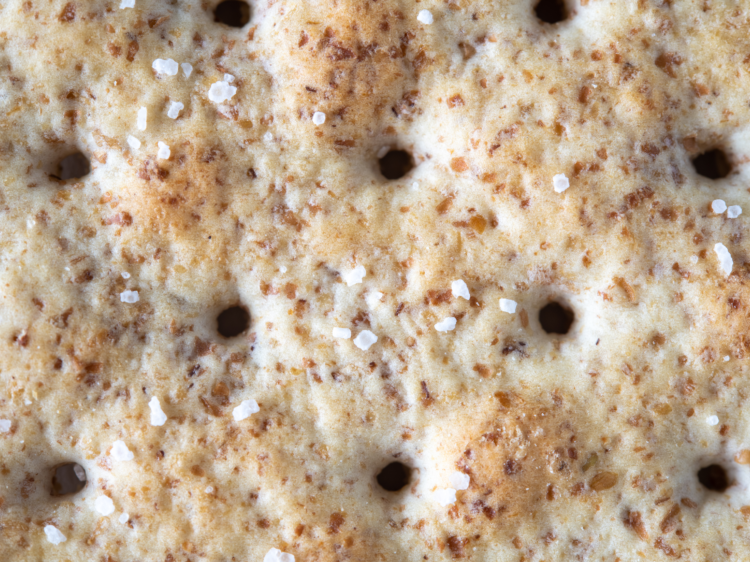Calling An Audible: Decoding Crispy and Crunchy Through Sound Science
By Ryan Dillman, Research Scientist, Sensory
Why Crispy and Crunchy Matter
If you’ve ever found yourself in the mood for a snack with a specific texture—maybe a crunchy cracker or smooth yogurt—you’re not alone; 69% of consumers say that texture influences their snack cravings.1 This unignorable insight shows that mouthfeel is a key part of the eating experience, every bit as much as taste, making it critical to get it right in your food product.
Of course, this holds true across all food categories, but mouthfeel is especially critical in determining the success of a snack. A snack might taste good, but if it doesn’t feel pleasant in the mouth or deliver the expected sensation, you’re unlikely to choose that product again. For product developers, understanding consumer preference in mouthfeel is essential; it could be the deciding factor between a one-time trial and repeat sales.
Much of my recent research has focused on foods like crackers and other items that many consumers broadly would refer to as crunchy snacks. Let’s pause and consider that word for a moment, “crunchy.” What does it really mean, and how do you define it? It’s not easy, is it? You know what it is, but describing it is challenging. Even harder is pinpointing the subtle differences between several crunchy snacks. And that’s before we throw the term “crispy” into the mix.
Although terms like crispy and crunchy can be elusive, they matter to product developers. When we present products to consumers, they provide feedback like, “This was too crunchy,” or, “This wasn’t crispy enough.” But what do these descriptors actually mean? How do we measure them - and how can we make the right adjustments? Our goal is to identify the specific attributes that define crispy and crunchy, and if they can be quantified in a meaningful and actionable way.
Traditional Approaches to Measuring Texture
Let’s explore our sample consumer feedback on crunchiness and crispiness. When I hear these terms, I ask other questions: what about hardness, denseness, fracturability, volume, and duration? Those are the attributes consumers are really talking about and the ones we deal with in product development.
To understand these variables, we’ve traditionally relied on descriptive panels. These are highly trained groups of people who spend time learning to calibrate their senses and describe and define product attributes. They can tell us at an attribute level how our solutions perform in real applications, whether it's sweetness intensity, flavor intensity, or mouthfeel terms like hardness, or the duration of sound while chewing.
Our North American panels are especially well-trained on crackers, thanks to extensive work in this category. While descriptive analysis is highly effective, it is time-intensive to both train and collect data. And while it gives us valuable insights, it doesn’t measure consumer terms like “crispy” or “crunchy” directly. The panel provides feedback on attributes like hardness, tooth pack, and density, which are not consumer terms. So, the question becomes, “What can we measure?” How do we know what mouthfeel terms matter to consumers, and how can we validate that we’ve changed the perception of crispy and crunchy?
The Experiment: Bringing Sound Into the Equation
We recognized that a vital component of crispiness and crunchiness is sound. Think about biting into your favorite cracker or potato chip. You might be aware of how the snack should sound at first bite, or you might notice if that familiar snap is missing or different. Sound is an important cue for your brain and goes a long way towards determining eating satisfaction. By better understanding this connection, we can design products that deliver exactly what consumers expect from that first bite.
This realization led us to ask: could we actually measure the sound as people chew? To explore this, we designed a study where participants ate different types of snacks, including crackers, chips, and puffs. Each person was recorded while chewing, and we standardized it by asking everyone to complete ten chews. That way, we could compare across individuals without the variability of someone who chews quickly versus someone who chews more slowly.
The recordings were made in a soundproof media room using three sensitive microphones pointing at the participant’s mouth. The sound data from each microphone was collated into a single monophonic soundtrack, one for each participant, and we created a graph of volume and sound duration. Using sound and speech analysis software, we were able to correlate specific data with an array of texture attributes.
Key Findings
Here are a couple of the key takeaways from the experiment. There were definitely some surprises.
Crispy vs. Crunchy
The findings made a clear distinction between the two terms. Crispiness showed a strong correlation with the sound recordings. Ten out of fifteen important variables for crispy came directly from those recordings, while the remaining five came from the descriptive terms. Products that scored high in crispiness tended to produce loud, shorter bursts of sound, especially in the first few chews.
Crunchiness was very different. We identified nine important variables, and none of them came from the sound recordings. Instead, crunchiness ties back to more panel-perceived attributes like hardness, denseness, the amount of chewing effort required, and volume perception and duration.
For me, this is one of the most exciting insights: crispiness is as much about emitted sound as it is mouthfeel, while crunchiness is fundamentally a human-perceived mouthfeel and sound property. This understanding can help focus research and development based on what had been rather nebulous feedback.
Consumer vs. Trained Panels
Another important outcome was the alignment between consumer data and trained panel results. When I mapped them side by side, they lined up remarkably well. There were small differences, but overall, what consumers described matched what our trained panels measured. These findings validated our approach—our panels capture exactly what consumers perceive, even when they use different words.
Towards a Better Crispy/Crunchy Scale
With this kind of data, it’s natural to ask whether we could create a standardized scale for crispiness and crunchiness, the way Scoville measures heat. That’s the long-term ambition.
There are challenges, though. When consumers give ratings for crispy and crunchy, their scores tend to fall within one or two points of each other on a 7-point intensity scale, making it hard to find the extremes. And existing definitions of crispy and crunchy are often nearly identical, which is part of what motivated this research in the first place.
Still, I believe there’s potential. Having a standardized scale would help us benchmark products, guide formulation, and even support marketing claims.
There’s still work to be done, of course, and other variables to consider. Just one example is where in their mouth our panelists should chew, and where we should record the sound. Generally, for our trained panel, we are measuring texture with the molars (back teeth). But with a lot of snacks, you're actually going to break it first with your front teeth. How and where we bite and chew varies by snack item and by person. Further testing should help establish reasonable midpoints for standardized testing that yield reliable results.
What This Means for Brands and R&D Across Categories
Much of this research has been done with crackers, chips, and extruded snacks. But, adding to the excitement and possibilities, the insights we gained reach far beyond snacking. Potential applications extend into coatings for fried foods, where texture is key; chocolates, where the snap is a critical quality; and inclusions like rice crisps, which contribute both texture and sound.
And it doesn’t stop there. Beverages are another interesting category we can look at through the lens of sound. For example, carbonation creates its own sound, and viscosity—and even packaging—can affect the slurp factor. Do gummies produce different sounds depending on whether they use gelatin or starch? Cheese curds squeak, and even fruits and vegetables like apples or celery can be described in terms of crispness.
For brands, these widely applicable insights are extremely practical. If consumers tell them, “I want something crunchier,” we can respond: “Great, we’ve got fibers, chickpea proteins, or starches that can give you harder, denser textures.” With sound analysis, we can back up those recommendations with more objective data.
That’s really the goal: if I give you hardness and denseness scores, I can also tell you what’s crispier or crunchier, and which ingredients are driving that. We want to bridge what consumers say with what we can measure. That alignment means we can design products that deliver on expectations more consistently, and we can do it more efficiently.
The Future Sounds Delicious
We’ve achieved clarity on what makes a product crunchy. Crispy, however, is still more nuanced and harder to define. This research showed that sound plays an important role in crispy, and that was an excellent finding, but one that opens even more questions. But that’s part of what keeps what I do here fun!
Looking ahead, we see great potential in harnessing technology. Imagine using a texture analyzer equipped with a microphone and Artificial Intelligence to capture and interpret the sounds of food and beverages to automate what currently takes hours of manual analysis or panel training? That may be the future.
Another question is whether machines can replicate human chewing. The texture analyzers we use have microphones built in, so in theory, they can capture fracture sounds. If those results line up with human recordings, we could analyze samples in a matter of minutes.
The challenge is that analyzers don’t replicate everything — moisture, saliva, or the mechanics of the mouth. Translating human chewing into analyzer data is still a work in progress. But if we can bridge that gap, it would make development faster and more efficient.
Crispiness and crunchiness are central to how consumers experience food. With this research, we’re moving from vague, subjective feedback to measurable, actionable insights. The next step is putting those insights to work in formulation. We can already design texture as deliberately as we design flavor; using sound data will help us open the door to new products and a better mouthfeel experience more quickly. That’s where we see the biggest impact of this work, moving from insight to innovation faster to give the brands we work with a competitive advantage.
At Tate & Lyle, we’re turning discoveries into practical solutions for real-world formulation challenges, helping you deliver the mouthfeel experiences consumers want.
1 Mintel, Snacking Attitudes NET, 2024

